Picking the right area rug size can totally change the vibe in your space. A rug that’s too small just makes things look off, but a giant one might swallow the room whole.
Remember to repin your favorite images!
Aim for your area rug to stretch at least 18-24 inches past your furniture on all sides. That way, everything feels connected and balanced.
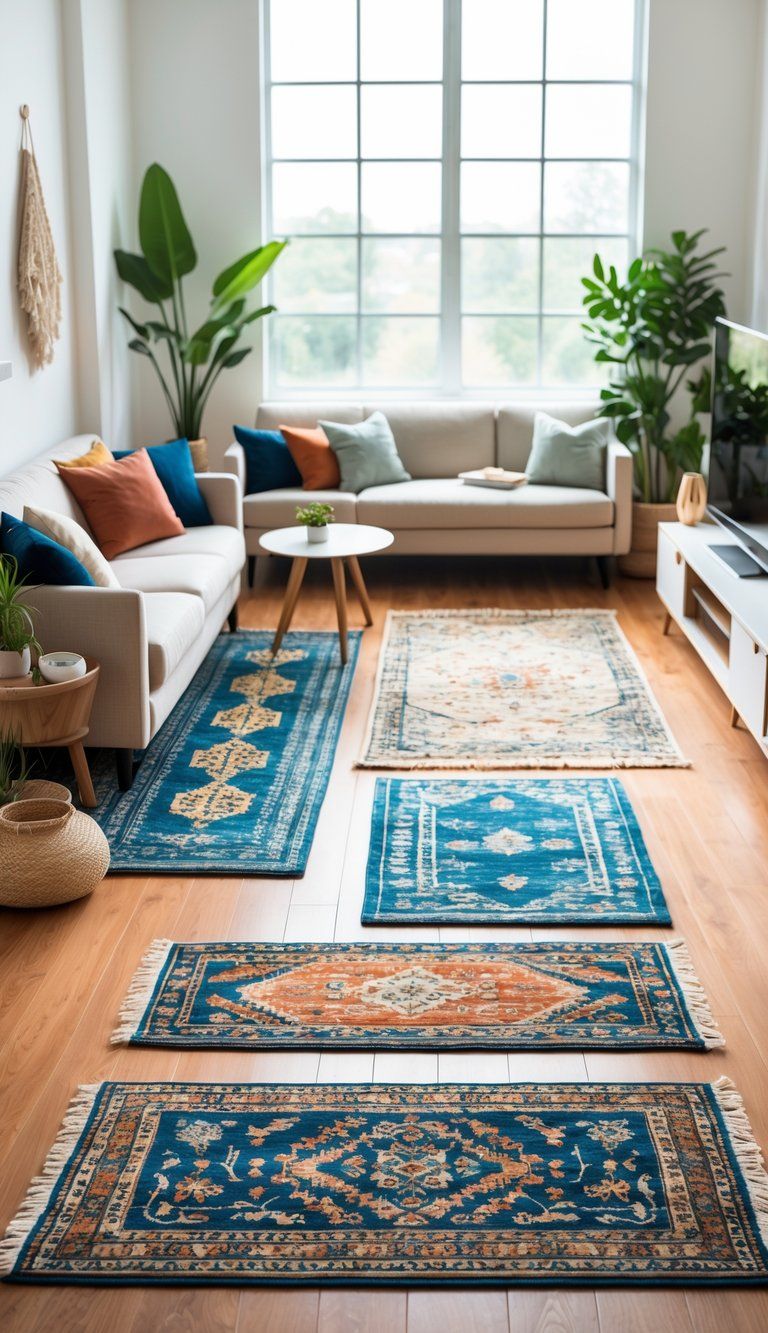
If you’re shopping for a bedroom rug, try a 9×12-foot rug under a queen bed. Make sure it extends at least 18 inches from the sides and foot.
That extra rug space gives you a soft spot to land when you get out of bed. In dining rooms, measure your table, then add 24 inches to each side so chairs don’t get caught on the rug’s edge.
Your rug choice does more than add comfort. It sets the whole mood for your room.
The right size rug anchors your furniture and really defines the space. Whether you’re dealing with a snug reading nook or a big living room, taking a few measurements before you shop can save you from some expensive mistakes.
Why Rug Size Matters
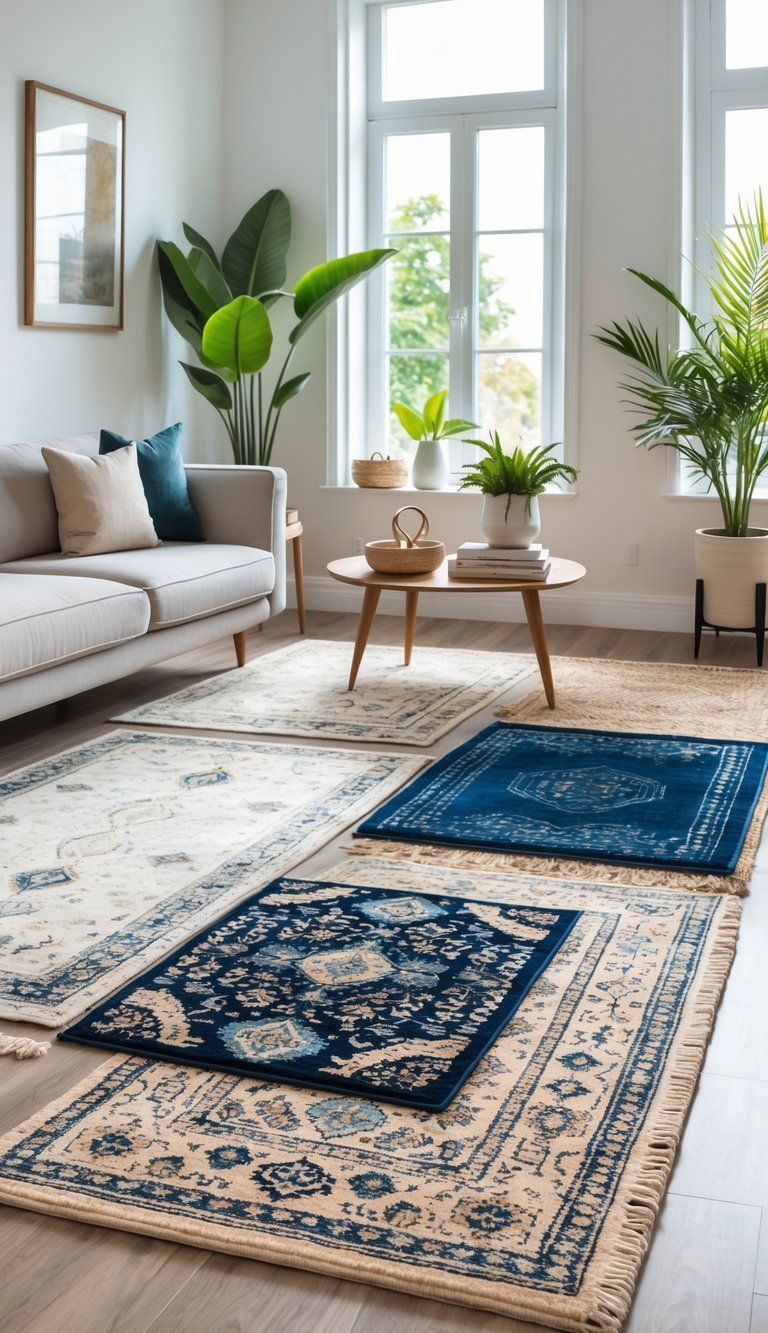
Picking the right rug size is a big deal in any room design. A properly sized rug brings visual harmony and defines spaces in a way that just feels right.
Impact on Interior Design
Rug size really shapes how a room looks and works. When you get it right, the rug pulls all your furniture together and makes the space feel cohesive.
If you go too small, though, the room just feels awkward and disconnected.
People often buy rugs that are too small because, let’s face it, smaller ones are cheaper. But honestly, that shortcut can mess up your whole design.
A well-sized rug:
- Defines conversation spots
- Creates boundaries in open layouts
- Adds texture and cozy warmth
- Complements how you’ve arranged your furniture
Think of your rug as a foundation piece—it’s worth investing in something that grounds your room.
Room Proportion and Balance
Your rug needs to fit the room and your furniture. In living rooms, let the rug stretch 6-8 inches past your sofa on every side.
That little extra makes things look planned and balanced.
For dining rooms, make sure the rug extends at least 24 inches past all sides of the table. That way, chairs stay on the rug even when you pull them out.
In bedrooms, you’ve got a few options:
- Large rug: Goes under the whole bed and nightstands
- Medium rug: Starts in front of the nightstands and extends 18-24 inches past the foot of the bed
- Small rugs: Place 8×10 runners on each side of the bed
Getting the proportions right keeps your room feeling balanced and comfortable.
Visual Flow and Comfort
A rug that fits well guides your eye and makes the space flow naturally. It also helps direct traffic and ties together open layouts.
Comfort matters, too. If your rug is too small, you’ll notice those weird transitions—one foot on, one foot off. Not fun, especially getting out of bed or off the couch.
Think about how people move around your space. In living rooms, put all furniture legs either fully on or fully off the rug.
Keeping everything “all on” usually works best for seating areas.
The right rug size gives you comfort underfoot and makes the whole room feel just right.
Essential Rug Sizing Principles
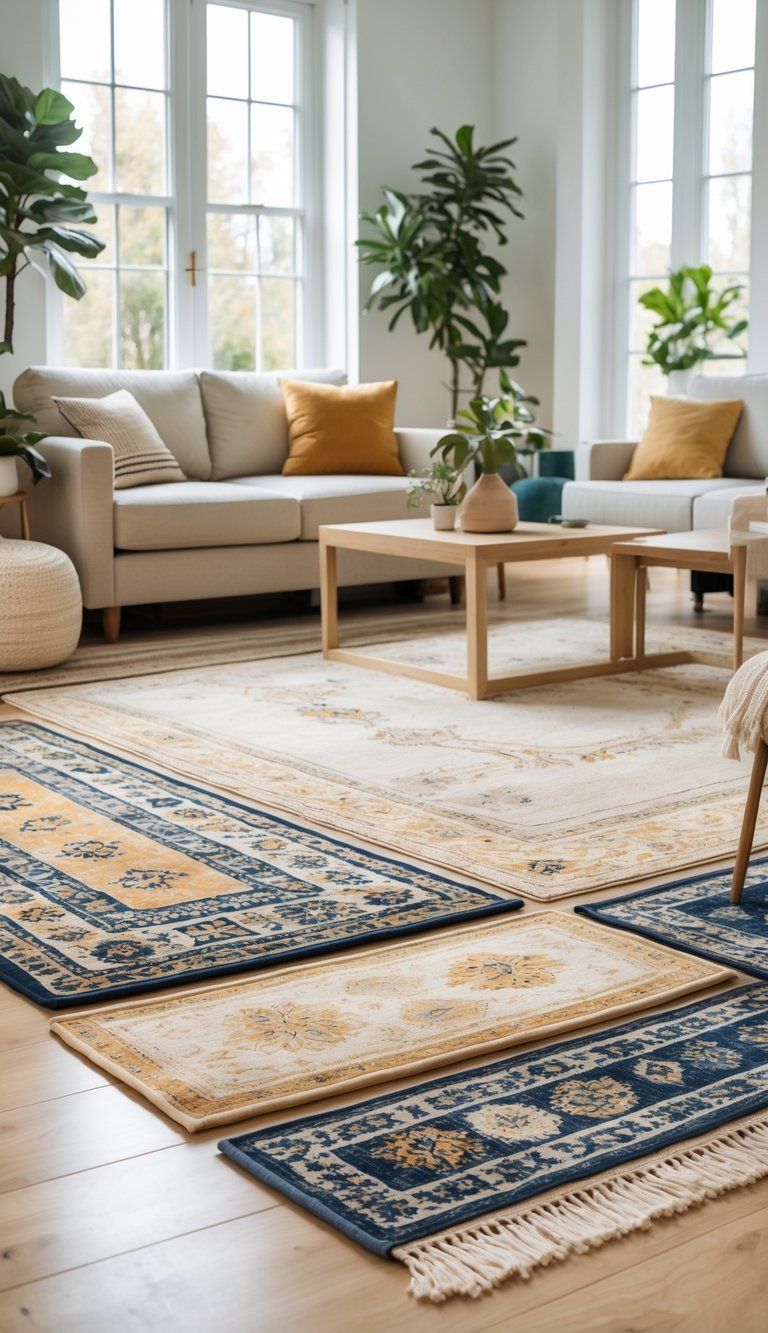
When you pick the right rug size, your space goes from feeling scattered to feeling pulled together. The perfect area rug anchors your furniture and brings everything into balance.
Measuring for a Rug
Start with a tape measure and figure out exactly what you need. For living rooms, measure your seating area and leave about 12-18 inches of bare floor around the edges.
In dining rooms, measure your table and add at least 36 inches to each side. That way, chairs can move without catching on the rug.
For bedrooms, decide what kind of coverage you want:
- Full coverage: Rug extends 18-24 inches past all sides of the bed
- Partial coverage: Rug starts at the foot of the bed and goes outward
- Side runners: Smaller rugs next to the bed
Don’t forget to check for doorways, vents, and floor changes before you buy.
Rug Dimensions Explained
Most rug sizes list width first, then length (W × L). An 8′ × 10′ rug? That’s 8 feet wide and 10 feet long.
American rugs use feet and inches, but imported ones might use centimeters. Watch out for that.
Here are some measurement basics:
Pile height: How thick the rug fibers are
- Low pile: Under ¼ inch
- Medium pile: ¼-½ inch
- High pile: Over ½ inch
Coverage area: The total square footage (width × length)
Always check the actual measurements online. Size names can be misleading and vary by brand.
Standard Rug Sizes Overview
Most area rugs come in standard sizes for common spaces:
| Rug Size | Best For | Typical Room |
|---|---|---|
| 3′ × 5′ | Accent rugs, entryways | Small spaces |
| 4′ × 6′ | Under coffee tables, small seating areas | Apartments |
| 5′ × 8′ | Small living rooms, under queen beds | Medium rooms |
| 8′ × 10′ | Living rooms, under queen beds | Standard rooms |
| 9′ × 12′ | Large living areas, under king beds | Spacious rooms |
| 10′ × 14′ | Open floor plans, great rooms | Very large spaces |
For dining rooms, make sure your rug goes at least 24 inches past the table. A 6-person rectangular table usually needs an 8′ × 10′ rug. Round tables pair well with round or square rugs.
If your room has odd dimensions, custom-sized rugs might be the way to go.
Room-by-Room Rug Sizing Guide
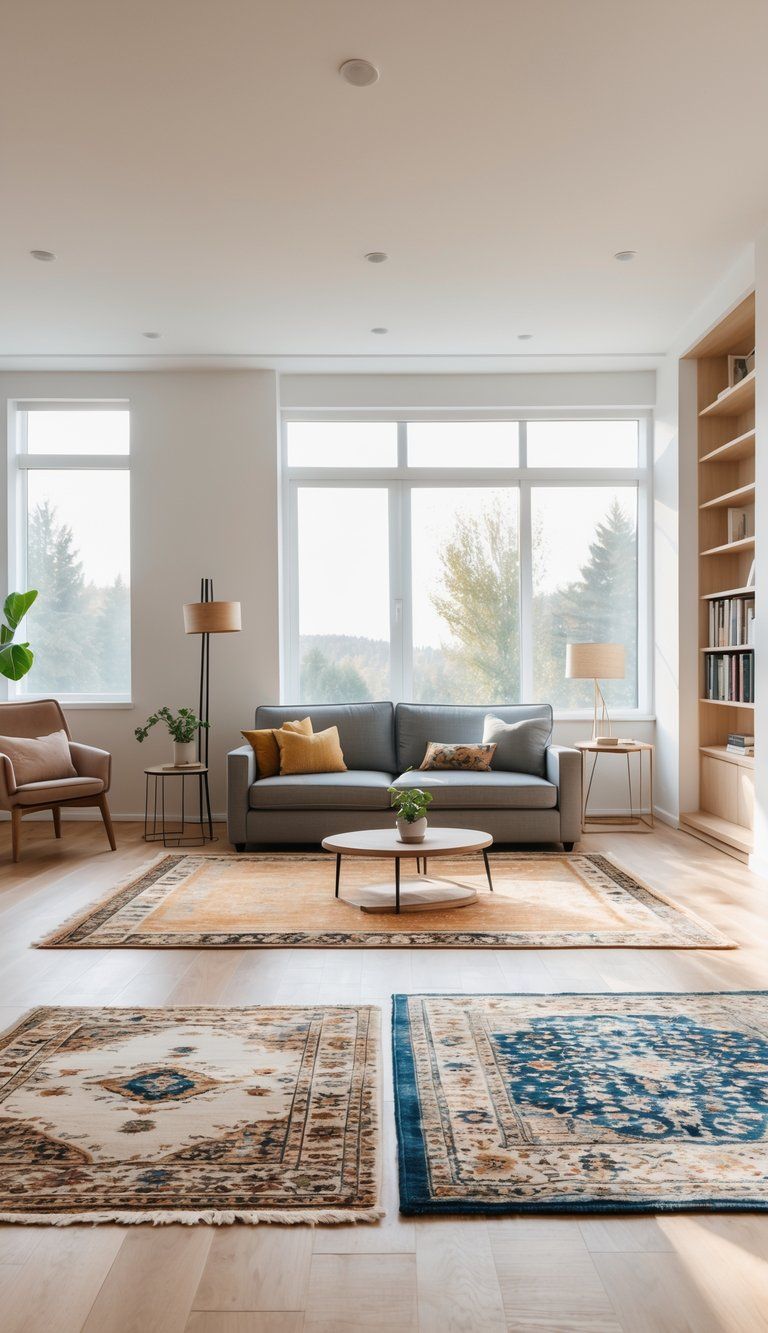
Getting the right rug size for each room makes everything feel balanced. The perfect rug adds warmth and style, but it also pulls your furniture and decor together.
Living Room Rug Size Recommendations
Your living room rug should help all your furniture feel connected. Here are three layouts to try:
All legs on the rug: Pick a large rug (9′ x 12′ or bigger) so every piece of furniture sits on it. This feels super luxe in big rooms.
Front legs only: Go for a medium rug (8′ x 10′) and rest just the front legs of your sofa and chairs on it. This is a nice balance of style and budget.
Floating rug: Place a smaller rug (5′ x 8′) in the middle with no furniture legs on it. This works when you want to show off a statement rug or you’re tight on space.
Leave 18-24 inches of floor visible between the rug and the walls. In open layouts, use rugs to mark off separate zones.
Dining Room Rug Selection
Your dining room rug needs to hold both the table and the chairs—even when you pull the chairs out. Make sure it extends at least 24 inches past each side of your table.
Quick sizing trick:
- Add 48 inches to your table’s length and width
- Example: A 36″ x 60″ table needs at least an 84″ x 108″ rug
Pick the shape that fits your table:
- Rectangle: Best for rectangular or oval tables
- Round: Works with round tables
- Square: Matches square tables
The rug should lay flat, so chairs don’t get caught. Low-pile rugs are easier to clean if spills happen.
Bedroom Rug Sizing Tips
Bedroom rugs make mornings a little nicer and help define your space. Here’s what you can do:
Full coverage: Lay a big rug (8′ x 10′ or 9′ x 12′) under the whole bed and nightstands. Leave 18-24 inches of rug showing on all sides.
¾ coverage: Use a medium rug (5′ x 8′ or 6′ x 9′) under the bed, covering the bottom two-thirds. The headboard area stays on the floor.
Bedside runners: Put smaller rugs (3′ x 5′) on each side of the bed. This is a budget-friendly choice.
For queen beds, go for at least a 6′ x 9′ rug. King beds need something bigger—8′ x 10′ or more.
Think about where you’ll step in the morning and make sure there’s a soft landing.
Entryway and Hallway Runners
Runners welcome guests and protect your busiest floors. In entryways, let 4-5 inches of floor show around the rug.
Entryway rug sizes:
- Small entry: 3′ x 5′ or 4′ x 6′
- Large foyer: 5′ x 7′ or a 6′ round rug
Hallway runners should be 2-3 feet wide, with 4-6 inches of floor on each side. Center the runner so there’s equal space at both ends.
Pick tough, stain-resistant materials like wool or synthetics for these spots. Darker patterns help hide dirt. Always use a non-slip pad to keep runners in place.
Specialty Rug Sizes and Shapes
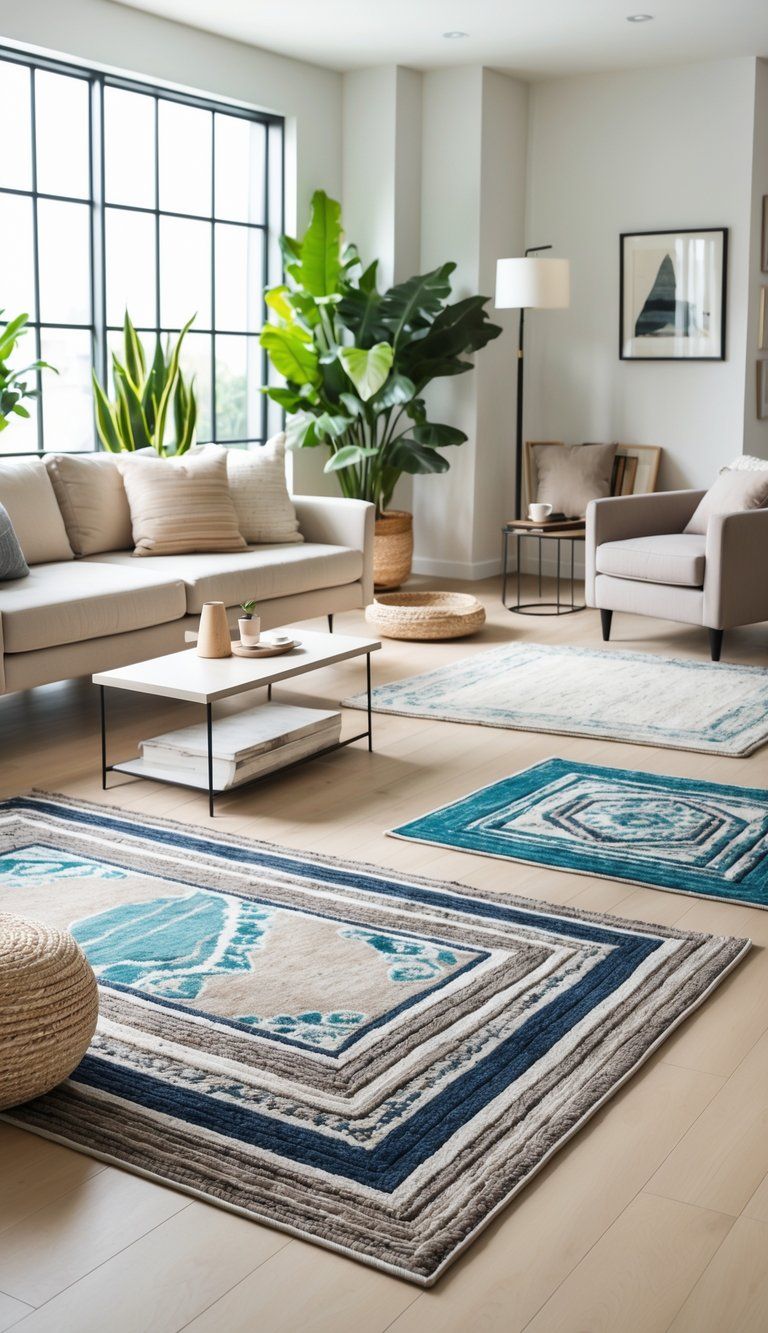
Not every room works with a standard rectangle rug. Sometimes you need something a little different to get the look just right.
Choosing for Unusual Spaces
Odd spaces—think hallways, entryways, or weirdly-shaped rooms—call for special solutions. For hallways, runner rugs are your best bet. They’re usually 2-3 feet wide and 6-12 feet long. The runner should be about 4-6 inches narrower than the hallway.
If you have an L-shaped room, you can use two rugs to define separate areas or order a custom-cut rug that fits the shape.
Entryways work well with smaller rugs (3×5′ or 4×6′) that don’t block the door. Measure carefully so you don’t end up with a rug that’s too big or tiny for the space.
Rounds, Squares, and Ovals
Round rugs look great under round dining tables and really echo the shape. Go for a round rug that’s 24-30 inches bigger than your table so chairs stay on the rug when pulled out.
Square rugs fit square rooms or tables. You’ll usually find them in 4×4′, 6×6′, and 8×8′ sizes. The same rule applies—make sure the rug extends past the furniture.
Oval rugs break up all those straight lines and soften the look of a room. They work nicely in:
- Dining rooms with oval tables
- Transition spaces
- Under freestanding bathtubs
Small Rugs and Rug Layering
Small rugs—think 2×3′ or 3×5’—work perfectly as accents in tight spaces. Toss one beside a bed, in front of a sink, or by the entryway to add a little color and texture.
People love rug layering these days. Start with a big, neutral base rug, maybe something natural like jute or sisal. Then throw a smaller, brighter rug on top.
This approach adds visual interest. It also helps you carve out zones in open-plan spaces.
Layering lets you use those bold, smaller rugs even in big rooms. Just make sure the bottom rug sticks out at least 12″ past the top one on every side.
That “frame” effect really makes both rugs pop. Don’t use thick rugs on the bottom, though, or you’ll trip every time you walk by.
Selecting Rug Size by Furniture Arrangement
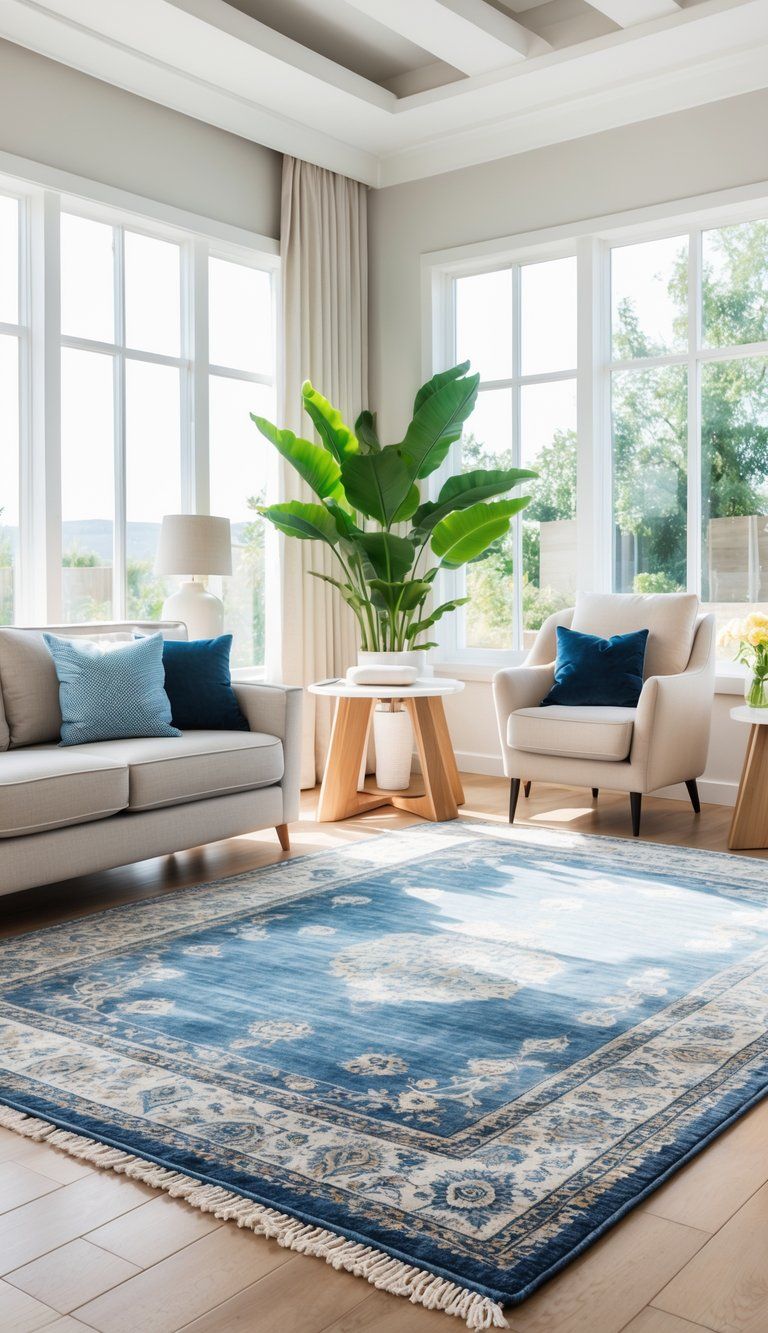
Your furniture layout basically decides what size area rug you need. The right rug pulls your furniture together and creates those visual boundaries that make a room feel finished.
Anchoring Furniture with Rugs
In living rooms, try to get all the furniture legs either fully on or at least partly on the rug. The “all legs on” method—usually an 8′ x 10′ or 9′ x 12′ rug—brings your whole seating area together. This works best if you’ve got the space.
If your room’s smaller, the “front legs only” trick might work better. Just put the front legs of your sofa and chairs on the rug. You’ll probably need a 5′ x 8′ or 6′ x 9′ rug for that.
For dining rooms, pick a rug big enough so chairs stay on it, even when you pull them out. Add about 24-30 inches to your table’s size to get the right fit.
Groupings and Multiple Rugs
Open floor plans can really benefit from more than one rug. Use different rugs to mark out distinct zones for dining, conversation, whatever you need.
When you go with multiple rugs, keep things visually connected by picking colors or patterns that play well together. They don’t have to match, but they should feel like they belong in the same family.
For L-shaped rooms or weird layouts, try two matching rugs to balance things out. This works especially well in big rooms where one giant rug would look strange or cost a fortune.
Leave 18-24 inches of bare floor between the rug and the walls in most rooms. That bit of framing looks so much better than wall-to-wall rugs, or those tiny “postage stamp” rugs floating in the middle.
Practical Tools and Tips for Rug Selection
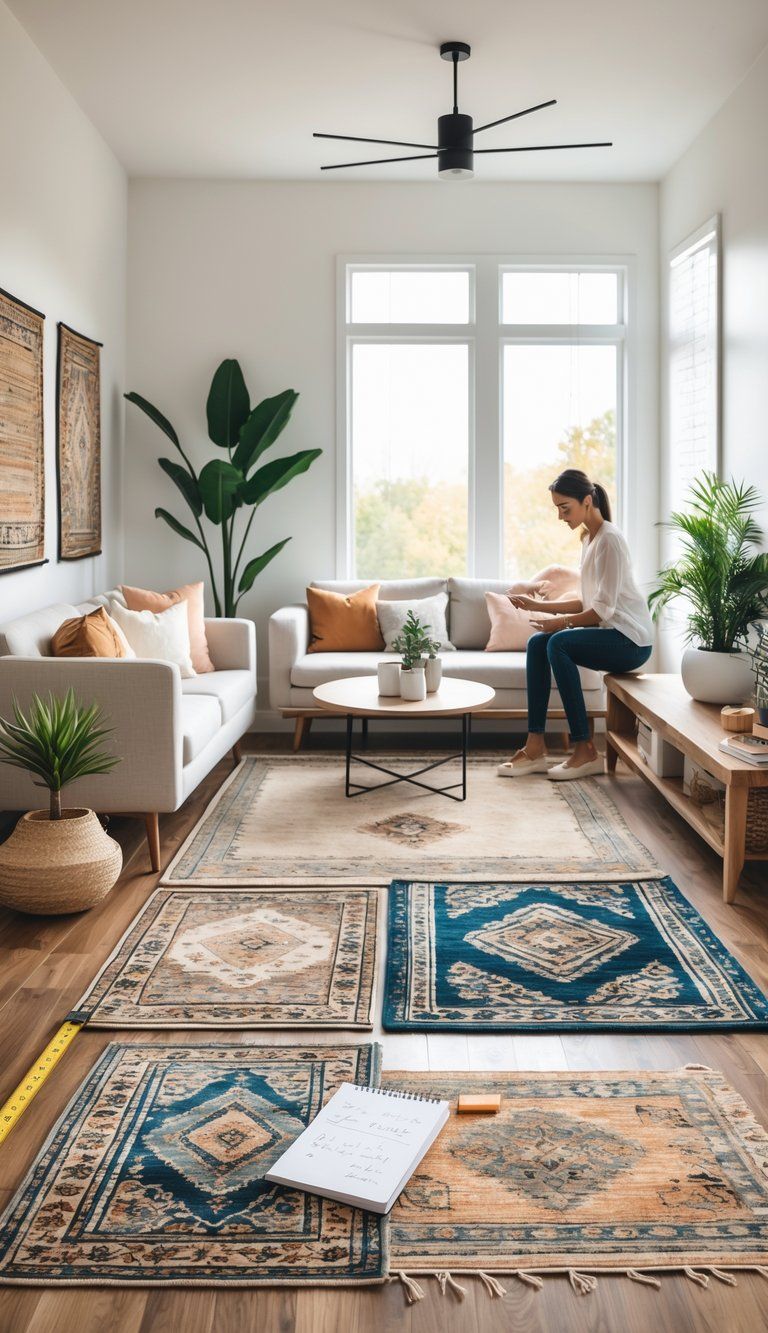
Picking the right rug size doesn’t have to be a guessing game. There are a few practical tricks that can help you picture things before you commit.
Using Painter’s Tape to Visualize Size
Painter’s tape is honestly one of the best tools for figuring out rug size. It lets you see exactly how a rug will fit before you buy anything.
Here’s how you do it:
- Measure the rugs you’re considering
- Use painter’s tape to mark out those dimensions on your floor
- Live with it for a few days
- Walk around and make sure you can move freely
- Try arranging your furniture inside or partly on the taped area
This trick can save you from expensive mistakes. Sometimes you’ll realize that 8×10 rug is actually too small, or that a 9×12 just swallows the room.
Consulting Rug Size Charts
Rug size charts give you a handy starting point.
Most guides suggest:
- Living rooms: 8×10 or 9×12 feet for standard spaces
- Dining rooms: At least 24″ wider than the table on every side
- Bedrooms: 5×7 for twin beds, 8×10 for queen, 9×12 for king
- Hallways: Runners should leave 4-5″ of floor showing on each side
Treat these as guidelines, not rules. Your room’s layout and furniture matter most.
Mistakes to Avoid
People usually pick rugs that are too small. That “floating rug” look makes a room feel disconnected.
Watch out for a few other things:
- Ignoring room shape—A square rug in a rectangle room? Never looks right.
- Forgetting foot traffic—Make sure rugs go under furniture in busy spots.
- Not measuring doorways—Check that doors can swing over your new rug.
- Skipping the rug pad—Always use a pad that fits to stop slipping and damage.
Take your time picking. The right rug anchors your space for years. The wrong size? You’ll notice it every day.
Choosing Rugs for High-Traffic and Special Use Areas

Some rooms just see more action than others. These spots need rugs that can handle a beating and still look good.
Kitchen Rug Sizing Considerations
Pick kitchen rugs based on where you stand the most. For in front of the sink, go for a 2′ x 3′ or a 2′ x 4′ runner. That gives you a soft spot to stand and doesn’t block the cabinets.
If you have an island, a 3′ x 5′ rug defines the area without getting in the way. In galley kitchens, a runner that’s 2′ to 3′ wide usually works best.
Leave at least 6 inches of floor showing around your kitchen rug. This keeps things from looking crowded and helps avoid spills.
Low-pile rugs—under ¼ inch—are best for kitchens. They won’t catch on doors and they’re easier to clean. Definitely keep rugs away from the stove, though; that’s just asking for trouble.
Bathroom Rug Size Solutions
Bathroom rug size depends on your fixtures. For a single sink vanity, a 21″ x 34″ rug usually does the trick. Bigger master baths might need a 24″ x 40″ rug.
Round rugs, about 30″ across, look great by freestanding tubs. For the toilet, a small 17″ x 24″ contour rug adds comfort but doesn’t trap moisture.
Leave at least 4 inches between your bathroom rug and the walls or any fixtures. That little gap keeps air moving and helps prevent mildew.
If your bathroom’s big, try coordinating sets with the right size for each spot. Just don’t let rugs overlap the toilet base or run under the vanity—those spots never dry out right.
Washable and Durable Rugs
Washable rugs really change the game for busy spaces. You want to find rugs marked as “machine washable” so you can just toss them in your regular washing machine.
A lot of newer options hold up to frequent cleaning and keep their color and shape. That’s honestly a relief if you’ve got kids or pets running around.
Materials make a huge difference when it comes to durability. Polypropylene, nylon, and polyester blends stand up to stains and everyday wear.
Natural fibers like wool and cotton with tight weaves can also handle a lot, though sometimes they need a bit more TLC when it’s time to clean.
Best Washable Rug Options:
- Flat-weave cotton rugs
- Indoor/outdoor rugs
- Synthetic low-pile rugs
- Modular carpet tiles
Low-pile rugs (anything under ½ inch) fit best in hallways and entrances. They don’t block doors and people aren’t as likely to trip over them.
If you’re picking a rug for the dining room, try a darker pattern. It’ll help hide those food stains that always seem to happen and still bring some style to the room.

